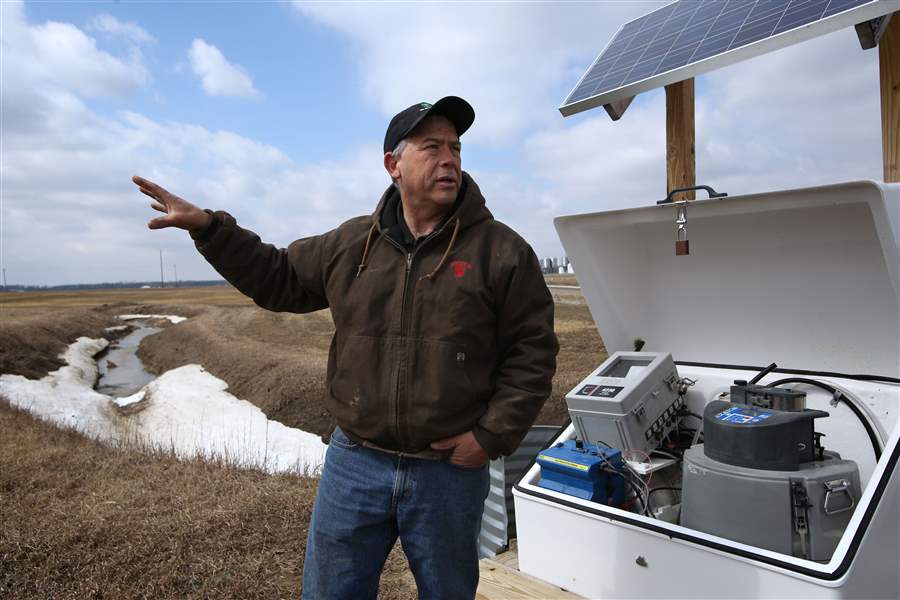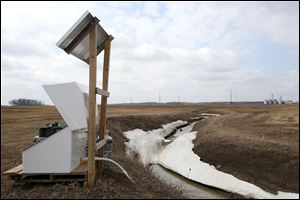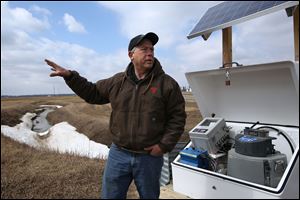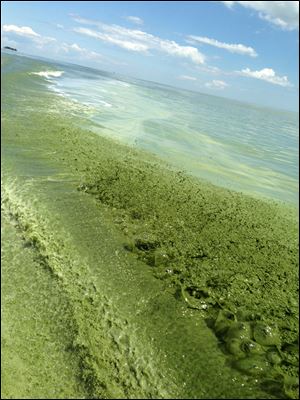
AREA FARMERS ON FRONT LINE OF CLEAN-WATER BATTLE
Fight against algae in full swing
Industry seeks solutions to curb runoff
3/23/2014
Terry McClure, vice president of the Ohio Soybean Council and an Ohio Nature Conservancy board member, is one of about 33 Ohio farmers who have volunteered to have the chemical composition of their runoff analyzed.
THE BLADE/KATIE RAUSCH
Buy This Image

Water runoff testing equipment is situated on Terry McClure’s farm in Paulding County, Ohio. Runoff goes into tiny Middle Creek and then into the Auglaize River which connects with the Maumee River in Defiance.
GROVER HILL, Ohio — As northwest Ohioans pack away their winter clothing and await the arrival of blooming flowers, fruits, and vegetables, the state’s agriculture industry is gearing up for the dawn of a new era in environmental stewardship — one it promises will yield long-term results for algae-infested Lake Erie and improve the quality of life for its residents.
The strength of that commitment won’t start to become apparent until at least mid to late-summer, when algae typically forms.
But this is the industry’s crunch time. Scientists in recent years have identified March 1 through June 30 as the most important window of time to curb runoff of phosphorus, nitrogen, and other nutrients that help algae grow.
There are many programs under way designed to achieve reductions, from a wider use of cover crops to one launched in the Holiday Inn French Quarter in Perrysburg last week that creates Ohio’s first statewide certification program for fertilizer applicators.
The latter is voluntary — as most Ohio agricultural programs are — and identifies which companies have successfully completed a new program that stresses the most responsible methods known for applying fertilizer, such as more site-specific injections of chemicals beneath the land’s surface.
Industry sees it as a market-driven solution that could fend off a looming threat of heavy-handed government regulations while being more proactive and allowing farmers to accomplish the same result with greater flexibility.

Terry McClure, vice president of the Ohio Soybean Council and an Ohio Nature Conservancy board member, is one of about 33 Ohio farmers who have volunteered to have the chemical composition of their runoff analyzed.
“There are a lot of us who are totally and completely committed to this program,” John Oster, a specialist in wholesale and national account sales for Morral Companies LLC, said at the program’s launch with a rousing, almost anthem-like conviction in his voice. “We are going to make it work. We are going to make a difference.”

Algae ‘as thick as pudding’ was photographed on Aug. 5, 2013, in the wake of a boat owned by Rick Butera on Lake Erie at Maumee Bay.
Field research
The certification program is part of a collective effort that officials say needs to be embraced by more than Columbus lobbyists and politicians.
The commitment, they said, must begin in the heart and soul of more farmers who share the passion of Terry McClure, 53, a Paulding County corn, soybean, and wheat farmer whose thick hands and firm handshake make as strong of a first impression as his warm, pleasant demeanor.
Mr. McClure is eager to help researchers such as Ohio State University soil scientist E.A. “Libby” Dayton and U.S. Department of Agriculture hydrologist Kevin King learn more about the soupy, chemical-laden mixture that flows off northwest Ohio farms, the stuff commonly known as runoff.
Scooping out a sample of runoff is better than nothing. But it only reveals a snapshot in time.
Mr. McClure, vice president of the Ohio Soybean Council and an Ohio Nature Conservancy board member, is one of about 33 Ohio farmers who have volunteered to have the chemical composition of their runoff analyzed on a 24-hour basis by scientific instrumentation powered by solar panels.
It’s called “edge-of-field” research.
The devices — one calculates nutrient content at the surface; the other from a tile drain — were installed last fall to generate baseline data.
They are expected to remain on site for years.
“Shame on us if they aren’t here 10 years from now,” Mr. McClure said.
Mr. McClure said he believes most farmers want to do the right thing.
“We will never get to zero runoff,” Mr. McClure said.
Agriculture, he said, is invariably a “leaky system” to some degree.
The amount of leakage has scientists worried.
In recent months, both the U.S.-Canada International Joint Commission and the state of Ohio’s phosphorus task force have called for fundamental changes in how farmers apply nutrients to their land.
Scientists who advised those boards said a huge reduction — possibly 40 percent or more — of runoff needs to be achieved for Lake Erie to heal.
Mr. McClure’s farm is hardly within eyesight of Lake Erie.
It is in Paulding County’s rural Washington Township, just east of the Indiana border.
It is a solid 90-minute drive — probably closer to two hours, with traffic — from the Lake Erie shoreline.

The challenge
Mr. McClure agreed that’s one of the biggest challenges in combating runoff: convincing farmers to work harder at addressing a problem that’s incredibly diffuse, spread across such a wide region, and impacting a lake that’s so far away many of them rarely see or use it.
In northwest Ohio, according to the U.S. Department of Agriculture’s Natural Resources Conservation Service, there are more than 4.2 million acres in the Maumee River watershed alone.
The Maumee is the largest watershed that drains to Lake Erie.
In Mr. McClure’s case, runoff from his farm goes into tiny Middle Creek, which eventually flows into the Auglaize River. The Auglaize connects with the Maumee in Defiance.
Agriculture is hardly the only source of algae-inducing phosphorus.
There are massive sewage overflows. Faulty septic tanks. Sunlight, heat, and climate change.
Some of the region’s top algae scientists — such as the University of Toledo’s Tom Bridgeman — believe phosphorus-laden silt the U.S. Army Corps of Engineers has dredged annually from Toledo’s shipping channel since the mid-1980s and redeposited in western Lake Erie’s Maumee Bay is a contributing factor.
But agriculture is owning up to its share of the problem, whatever that is.

Microcystis
At last week’s kickoff for the new certification program, some industry officials said they’ve heard estimates tossed around of how agriculture could be responsible for as much as 70 or 80 percent of Lake Erie’s phosphorus.
They agreed that, conservatively, agriculture was likely responsible for at least half.
To Mr. McClure, anything more than 30 percent means they need to refocus on their own operations.
“We looked in a mirror,” he said. “We realized we were pointing fingers and fingers were being pointed back at us.”
The problem is hardly new.
Lake Erie’s most troublesome form of algae, called microcystis, re-emerged in the lake’s western basin in 1995 — 19 years ago — following a long absence.
It wasn’t until 2010 that the Ohio Environmental Protection Agency began testing for it.
The algae has a toxin, called microcystin, capable of making people sick or even killing them.
Scientists are now learning the toxin may be more durable than originally thought, and continue to linger in the water well after the summer algae has dissipated.
The problem became a bigger priority to state officials in recent years after charter fishing boat captains became more active in Columbus politics, complaining of losing clients. Other businesses, including Cedar Point, joined the chorus of how algae is wreaking havoc on the state’s valuable tourism and recreation industries.
Then, last September, Ohio had its first publicly owned water treatment plant, a facility in Ottawa County’s Carroll Township that serves 2,000 customers, become so overwhelmed by the toxin it was forced into an emergency shutdown.
Cash-strapped Toledo spent $4 million — including an additional $1 million in emergency funds — to ward off the toxin.
Area plant operators now urge state and federal environmental regulators for guidance on how to handle a big influx. They say that, while they have been successful to date, there is not a standard protocol and they don’t know what works best in each circumstance.
All of that led to more calls for regulating agriculture’s runoff.
The ‘4 R’s’ message
The cornerstone of the new certification program is what agriculture calls its “4 R’s” of fertilizer application: the right source, the right rate, the right time, and the right place.
It is admittedly part public relations.
Lara Moody, director of stewardship programs for the Fertilizer Institute, an industry lobbying group on Capitol Hill, said the 4 R’s is meant as a “succinct message to the public” that agriculture is taking its responsibility with fertilizers more seriously.
The Andersons Inc. of Maumee was one of several businesses that participated in a pilot certification program last year as a test case.
Doug Busdecker, Andersons area general manager for farm centers, said land stewardship is “the heart and soul of the American farmer.”
“Agriculture wants to do the right thing,” Mr. Busdecker said.
He said he was impressed that 175 businesses attended last week’s launch of the certification program.
Eighteen signed up.
Recent efforts to improve Lake Erie’s water quality include legislation in the Ohio Senate that creates incentives for crop farmers to, among other things, voluntarily develop nutrient-management plans.
But the legislation does nothing for controlling how livestock manure from concentrated animal feeding operations, or CAFOs, is stored and applied on area farmland.
Vickie Askins of Cygnet, a CAFO watchdog and spokesman for the Ohio Environmental Stewardship Alliance, has called that loophole ridiculous. She and other activists are urging state officials to pass a law that, at the minimum, requires a ban on winter applications of manure on cropland. They argue the waste does not penetrate the soil when it’s frozen, and winds up damaging water quality.
They hope to have their concerns addressed in the House version of that bill.
In a keynote speech at Thursday’s Lake Erie Waterkeeper conference at Lourdes University in Sylvania, J. Patrick Nicholson, N-Viro founder and a former Toledo Lucas County Port Authority president, said the threat to water quality from uncontrolled or improperly managed manure has been largely overlooked.
But there are signs of progress in other areas.
At the urging of Ohio Sen. Randy Gardner (R., Bowling Green), Gov. John Kasich has proposed $10 million over two years to help fight Lake Erie algae.
The proposed expenditure, in the governor’s $2.4 billion budget plan released Tuesday, would be used to seek alternatives to open-lake disposal of dredged material in the Toledo and Cleveland areas.
“I’m optimistic we’re really starting to turn the corner and see the lake restored to what it should be,” Mr. Gardner told conference attendees.
Lake Erie’s algae is a multifaceted problem.
Few people dispute that.
But many farmers now also acknowledge they need to remain open to changing some of their longstanding practices, based on what the evolving science of runoff and algae uncovers.
Said John Motter, a Hancock County farmer and ex-officio board member of the soybean council: “The landscape of agriculture has changed and will continue to change and we have to be agents of change.”
Contact Tom Henry at: thenry@theblade.com or 419-724-6079.